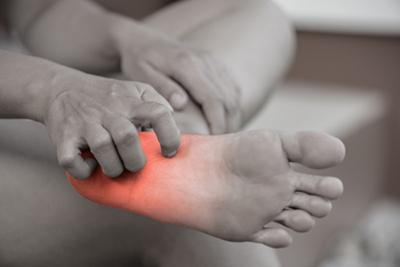
Plantar fasciitis refers to a foot condition most often described by heel pain, which feels most intense in the morning after a night’s sleep/rest. Dr. Daniel Waldman of Blue Ridge Foot Centers in Asheville, NC, knows that recognizing common triggers of plantar fasciitis is a smart way to help prevent or, if necessary, manage this condition.
Risk Factors & Early Warning Signs of Plantar Fasciitis
This foot condition is most prevalent in individuals between 40 and 60 years of age. However, other inherent risk factors that may encourage its development include –
- Specific foot structures – i.e., flat feet, high arches, or a nonconforming walking pattern.
- Excess weight will put stress on the plantar fascia ligament running along the sole of the foot.
- Certain occupations require standing/walking (on hard surfaces) for extended time periods.
Early Warning Signs
The following offer early insights into a potential condition –
- Sharp heel pain for first morning steps.
- Amplified discomfort after stretches of inactivity.
- The arch has a burning/aching sensation.
Recognizing Common Triggers of Plantar Fasciitis
To stay proactive and avoid a flare-up of plantar fasciitis, understand the common triggers that include –
- Overuse - excessive walking/running/standing/jumping often adds stress to this band of tissue connecting the toes and heel bone.
- Tight Calf Muscles – naturally tight calf muscles can contribute to pulling on the plantar fascia.
- Rapid Weight Gain – excess weight stress to the feet and entire system.
- Wrong Footwear Choices - wearing flat, worn-out, or poorly fitting shoes can increase pressure on the plantar fascia.
In addition, activities requiring repetitive movements (long-distance runners/dancers, etc.) tend to increase the risk of plantar fasciitis developing.
How to Avoid Triggers of Plantar Fasciitis
Fortunately, there are practical measures one can take as this will help you avoid triggers and the painful symptoms of this ligament when inflamed or aggravated –
- Gradually increase the duration/intensity of exercise/activities to prevent unnecessary/harmful stress on the plantar fascia.
- Routinely stretch calf muscles/plantar fascia. It is best done in the morning.
- Choose supportive shoes and avoid flip-flops/bare feet. Proper shoes include –
- Proper arch support.
- Sufficient toe box room.
- Cushioning.
- Maintain a healthy weight.
When pain is felt, it is essential to rest and apply ice to the impacted foot to reduce inflammation. If the condition persists, it may be best to contact a qualified podiatrist like Dr. Waldman.
Contact a Leading Asheville, NC, Podiatrist Near You Today
If you suspect you have plantar fasciitis, it's vital to consult with a podiatrist/healthcare professional to ensure an appropriate diagnosis and treatment is provided. For more information, contact Dr. Waldman or a Blue Ridge Foot Centers staff associate at 828-254-5371 or online.
